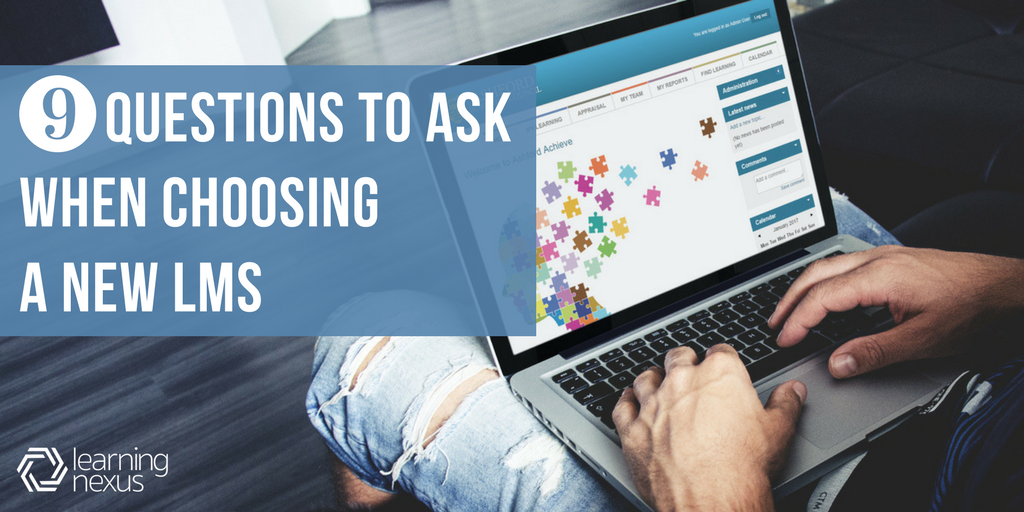
1. Do I need a cloud or hosted LMS?
Do you need a cloud LMS or an hosted/installed LMS? The main difference being that a cloud LMS is hosted on your supplier’s server as part of the package. Whereas an installed LMS is run on your organisation’s servers. Most organisations now look for a cloud-based LMS, as it usually lowers your expenses, increases accessibility and allows for a faster deployment.
2. What am I trying to achieve?
Are you trying to be more adaptive to change in your organisation? Perhaps you currently use face-to-face training which doesn’t allow you to respond to demands as quickly as desired. You may need an LMS that integrates with an authoring tool to allow you to create training on demand. Or perhaps you simply need something that is flexible and allows you to add new training when required. This could even involve combining online training such as eLearning with offline methods, such as classroom sessions or group work.
Increasing engagement is likely to be a key goal for many organisations. Some learning management systems will offer more engagement features than others. You may want to find systems that allow for enhanced social learning, such as a forum function or integration with social media.
3. Does my organisation need to be mobile-ready?
Perhaps you’re trying to achieve enhanced accessibility for your workforce. Many organisations face the challenge of ensuring all staff have access to training, despite their work-base or form of employment. This can be troublesome if training is restricted to the classroom. But a flexible LMS that offers accessibility by desktop computers and mobile devices could be exactly what you need.
4. How tech-savvy are we?
Do you have an organisation full of tech-loving millennials or do you have employees with mixed capabilities? You need to consider whether your prospective LMS is intuitive enough and easy to use. This will ensure everyone has equal opportunity to access learning and aren’t put off by the difficulty of completing training.
Of course, you’ll need to consider the basics such as how users will sign on and find the necessary training. There are, however, further accessibility features to remember such as the ability to facilitate captions and subtitles for those who are hearing impaired. If you have employees globally, you may want a system that can also support translated versions of your eLearning courses.
5. What do I need to get out of it?
Chances are you need to be able to produce sophisticated reports in different formats. Rather than wasting hours of admin time, many LMSs offer customised report settings or the opportunity to select your own formats.
Have you got a specific learning strategy within your organisation? You may have an ideal learner journey in mind which will determine different requirements from your LMS. For example, do you need the ability to set pathways for learners to ensure they stay on track? Many systems, such as Totara Learn, allows you to set up a program of learning. This can be targeted at specific job roles or groups and the progress can be easily tracked and reported on.
6. Is it scalable?
If your organisation is steadily growing, you’ll need an LMS that can match the growth. Does the LMS you’re considering allow for users to be easily added? Functions such as bulk uploads of users can be helpful when setting up an LMS. You’ll need to consider how a growing organisation may impact on the cost of an LMS and this should be factored in to your decision.
Not only should the practical elements be considered, but other functionalities such as being able to determine hierarchies within the LMS and different groups of employees will be an important element for a growing business.
7. Will it represent my organisation?
One of the simplest ways of ensuring the workforce engages with online training is when the LMS matches the branding and values of the organisation. Ultimately, the LMS will form part of your organisation’s overall strategy. Therefore, make sure your LMS has a section that is customisable to reflect your organisation, such as being able to add photos or promote different events and opportunities.
8. Will it integrate with existing HR?
There’s no avoiding the fact that a transition to a new LMS can seem like a daunting task. There is, however, a way of making this process a lot easier. Many LMSs, including Totara Learn, will integrate with your HR systems, meaning data entry tasks are minimised and organisational data gets regularly updated.
9. How will I measure the impact?
An investment in a new LMS is only worthwhile if you can witness and report on the impact it has on your workforce. This can be achieved in numerous ways but many LMSs will help extend your options. For example, will the LMS allow you to add questionnaires at the end of an eLearning course, allowing you to gather important feedback?
Systems like Totara Learn will help you measure learners’ progress in detail which can help attribute towards attempts to measure overall organisational impact. If you’ve increased the accessibility aspects of learning by introducing the new LMS, the value of this engagement and opportunity to learn should also be considered as a positive impact.
Still hunting for an LMS and not sure what options will suit your organisation? Totara Learn is part of our NexusComply compliance solution. The cloud-based LMS is sophisticated in providing the public and private sector with modern learning capability for their workforce. It offers endless functionality to help your organisational reach its goals, whilst the content and support that Learning Nexus provides will help to create the full 360° compliance solution.
